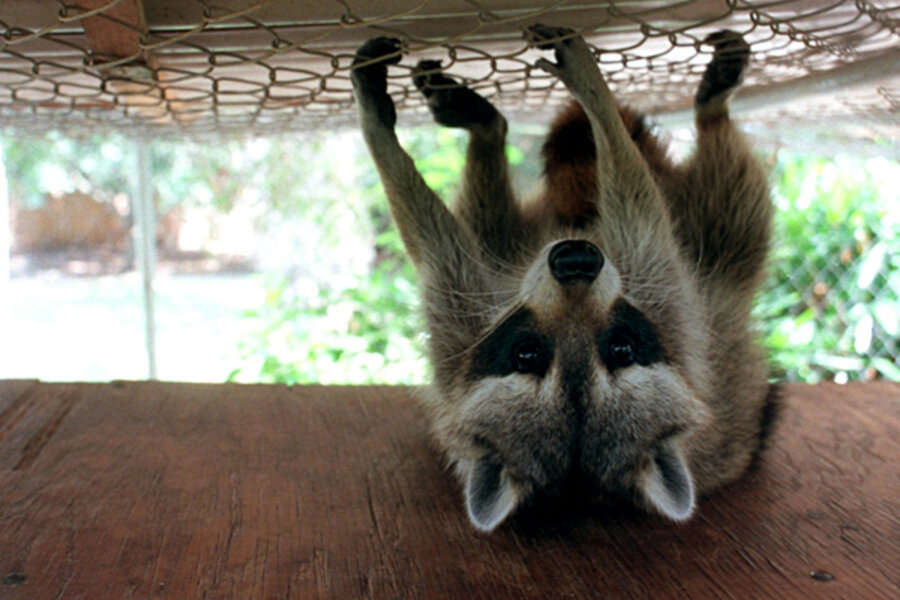In Toronto, frustration and the rise of the 'uber-raccoon'
Loading...
| Toronto, Canada
Finding ever more ingenious ways to stop raccoons from damaging their property is a fundamental part of life for many homeowners in Toronto. But the typically good-natured attempts to thwart the animals shifted to a heated debate over how to control them when police arrested and charged a man earlier this month for allegedly attacking a family of raccoons with a garden spade.
Police led Dong Nguyen, 53, away from his west-end Toronto row house in handcuffs just before 6 a.m. on a weekday morning and charged him with cruelty to animals and possession of a dangerous weapon. A neighbor had called police, saying he heard what sounded like screaming and ran outside to find a man knocking a kit raccoon off a fence and beating it with a spade.
Mr. Ngyuen’s wife, Thuy, said there was a misunderstanding and her husband was just trying to scare the raccoons away with a broom. But animal rights activists are calling for a heavy sentence for Dong Nguyen, 53, who faces up to two years in prison if he is convicted.
Raccoons thrive in modern cities, mostly because they have a ready food supply. Some studies have found that North America’s urban raccoon population is twenty times larger than it was 70 years ago, and Toronto, dubbed the raccoon capital of the world by an investigative public television program, is believed to have an especially high population.
Nguyen’s neighbors say he deserves leniency, and that the government should devote more resources to controlling Toronto’s large raccoon population.
“I don’t support violence but people are frustrated. They’re at the end of their rope,” said Jack Fava, a community activist who lives down the street from Mr. Nguyen and organized an anti-raccoon rally to protest his arrest.
“You can’t just say, ‘we’re protecting wildlife and it’s too bad for you, Mr. Jones.’ I just find that as taxpayers and citizens we deserve better.”
Has tolerance gone too far?
The city’s policy is to leave the animals alone and to encourage homeowners to keep them away by locking up their trash and ensuring potential nesting sites, such as attics, porches and crawl spaces, are inaccessible to wildlife. Provincial wildlife protection laws say animals can be moved, but no further than half a mile away. If an animal is killed, it must be done humanely.
“We have to remember that they were here first. We’re encroaching on their territory because of urban development. So we have to learn to become as tolerant of them as they have become of us,” said Scott Sylvia, an investigations officer with the Ontario Society for the Prevention of Cruelty to Animals.
But Toronto residents like Mr. Fava say they are fighting an uphill battle. He said he has spent hundreds of dollars to remove raccoons from his attic and to repair damage to a crawl space under his kitchen. He also has the latest “raccoon-proof” locks on his outdoor trash bins, but the raccoons have figured out how to open them. He often finds his trash strewn on the sidewalk.
“I’ve been dealing with it since ’98. I don’t grow any more vegetables. I don’t get to eat them because other animals, raccoons, get to them before I do,” he said.
Shaping an 'uber-raccoon'
In typical Canadian style, Mr. Fava and some of his neighbors want city and provincial governments to compensate them for the damage caused by raccoons. They also want the city to reduce the raccoon population or set up a program to neuter them.
Raccoon experts say reducing or neutering the population would be futile because numbers would soon rebound – raccoons can adapt to most habitats, reproduce easily, and have no natural predators. A 1998 study in Ontario found that the raccoon population size remained stable, even after 30 percent of them were removed, because new raccoons moved in to the vacated territory. The study also showed that the population grew once again after the removal program stopped.
A recent study suggests that by trying to control the animals, humans are making them smarter.
“One of the things we’re doing is providing them with bigger and bigger challenges so we’re actually shaping an uber-raccoon that is going to be able to compete in an urban environment,” said Suzanne MacDonald, the study author and a behavioral psychologist at Toronto’s York University.
MacDonald tagged five raccoons with GPS systems and traced their movements over several months. She found they stuck to a territory of about three blocks, which was usually defined by busy streets. She said they rarely crossed streets, and when they did it was at around 5 a.m., when there was no traffic. MacDonald said that suggests the animals have learned what time is best for avoiding cars, which remain their biggest threat in urban areas.





